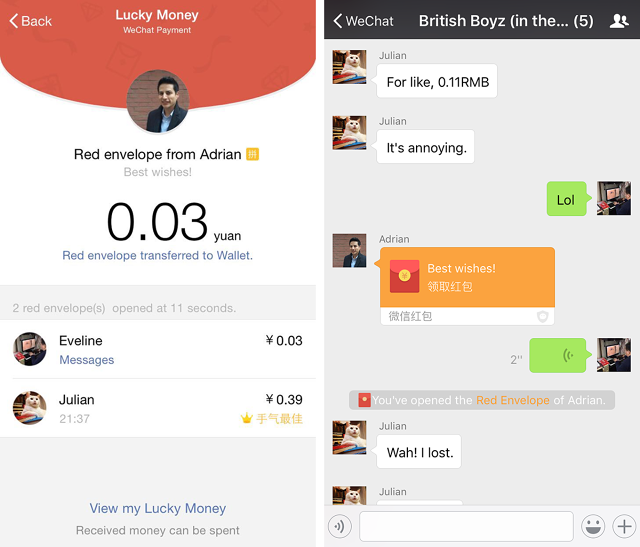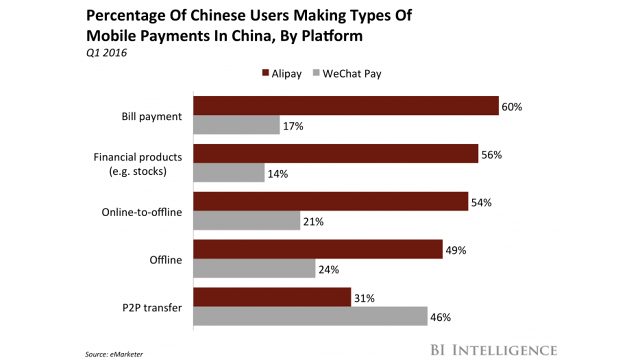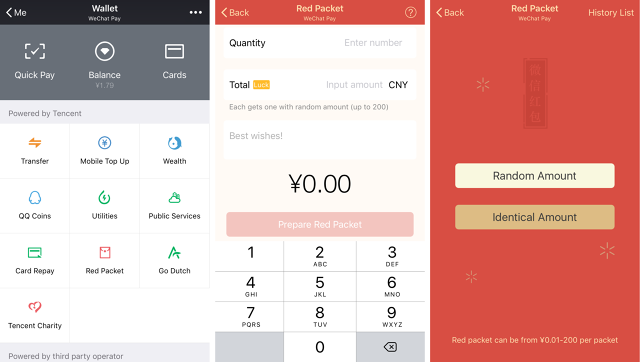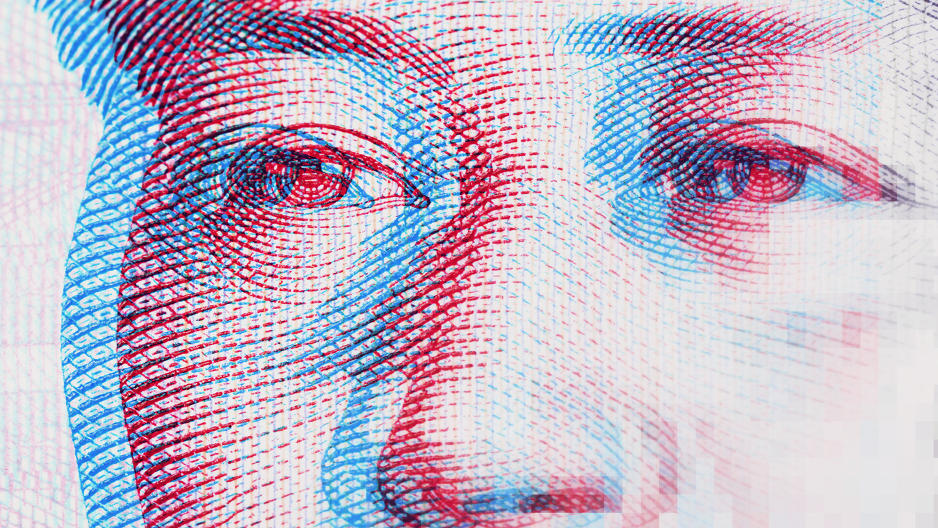How Social Cash Made WeChat The App For Everything
A little over a year ago, my roommate Mike said something strange. He’s a theater director and was working on a production in China. Mike complained that the play’s producer had imposed a no-stickers rule on the production’s WeChat group, but people kept sending them anyway.
Up until then, I had thought of WeChat as a social messaging app, like Facebook crossed with WhatsApp. But it turned out that in China, where relatively few people use email, almost everyone uses WeChat. In a country of 710 million internet users, Tencent, the Shenzhen-based goliath that owns WeChat, reports that as of September, the app has 768 million active users—up 35 percent over the same period last year. When an app popularized in part through the exchange of horse-dance GIFs and cartoon anthropomorphic dumplings becomes the default platform for work communication, you’re going to have a sticker problem.
Things got really weird, though, when Mike started mentioning the Red Packets. It’s a feature WeChat introduced in 2014 to exchange money electronically, based on the age-old Chinese custom of giving red envelopes filled with money at weddings, holidays, and special occasions. Mike said whenever people weren’t checking their messages enough, the producer would send a red envelope to the group, and everyone would go crazy. To me it sounded bizarre, the equivalent of your boss tossing a fistful of change at your cubicle. The producer would also send red envelopes as a reward to the cast and crew for their hard work.
I was in Beijing for the last weekend of the show’s run, and can happily say all those red envelopes seemed to pay off. I returned to the U.S. still mystified by the phenomenon. A few days later, a Red Packet icon appeared in a chat stream I had going with friends back in China. I tapped on it, and a full-screen message announced that I had received 0.03 yuan—a fraction of a cent. It also said my friend Julian had opened one too, that we had taken 11 seconds to do so, and that I had opened mine first. I felt ridiculously excited, like I’d won way more than part of a penny.
That was when I started to understand the competitive, gambling-like thrill of Red Packets. Like many other payment apps, WeChat allows its users to send Packets of predetermined amounts to each other, either individually or in groups. But it also encourages users to send money to groups in randomized amounts.
Say you have a chat group with five pals. You can put $5 in a red envelope and set it to disburse equally, so each friend gets $1. Alternatively, you could stipulate that the first two people to tap will get all the money in equal portions—$2.50 each—or that the first two people get a random cut, maybe $1 for one person and $4 for the other. The result is that any time a red envelope appears, people scramble to tap on it as fast as possible. (The packets expire in a day, adding to the time pressure.) Only afterwards do they see how much money they’ve won, giving it an addictive element of surprise. So addictive, in fact, that third-party apps now exist that let users grab red envelopes without unlocking their phones.
Back in our chat stream, Julian wrote, “Wah! I lost.” I started to type a reply, then noticed something new had appeared—a digital wallet containing 0.03 yuan. And because I now had a WeChat Wallet, a host of other features appeared too: a button to buy movie tickets, one to book train and plane travel, another to hail a car, one to pay utility bills, and more. Suddenly I’d been lured into their payment ecosystem.

Since I live in the U.S., I couldn’t actually use those features, but back in China, my friends could, and they’d become hard to resist. It had changed their lives, they said. Like many others across the country, they live in WeChat all day long, talking to friends and work colleagues, hailing cars, paying for restaurant meals that previously required cash (credit cards are still a rarity in China), and shopping in online and real-world stores that partner with WeChat. And for most of them, the gateway to it all was an ancient custom made digital.
Shaking Up An Old Tradition, Literally
WeChat introduced mobile pay in 2013, a year before its Red Packets, but it’s the latter—with its seductive blend of social networking, gaming, and gambling—that got users on board with the concept of sending money electronically. Today, out of WeChat’s 700-plus million active users, nearly 300 million have added their bank information to WeChat Pay, enabling them to withdraw from and add money to their virtual wallets. That’s contributed to the most bustling mobile payments economy in the world: In 2015, China’s mobile transactions surged to $235 billion, surpassing the U.S. for the first time. According to iResearch, China’s mobile payments market is estimated to be worth 15.7 trillion yuan in 2016—28 times the $62.5 billion forecast by eMarketer for the U.S. in 2017—and 28.5 trillion yuan in 2018.
Red envelopes have seen similarly explosive growth. When the envelopes debuted in 2014 during Chinese New Year, the number of people using WeChat payments more than tripled from 30 million to 100 million in a month. Over the six-day holiday, users sent each other 20 million red envelopes. One year later, that number reached 3.2 billion.
That stunning growth was in part the result of a masterful bit of marketing. Tencent partnered with China Central Television’s Spring Festival Gala, an annual TV event watched by an estimated 700 million people. (Think the Super Bowl times seven.) Throughout the show, viewers were prompted to shake their phones for a chance to win a combined $80 million in red envelopes from corporate sponsors. (WeChat has a “shake your phone” feature that’s normally used to connect strangers who are shaking their phones at the same time.) The company said that 20 million viewers shook their phones 11 billion times throughout the show. Afterwards, news stories reported that some people had jerry-rigged contraptions to shake multiple phones at once.
This past Chinese New Year destroyed the previous year’s records: more than 420 million WeChat users sent a total of 32 billion red envelopes—a tenfold percent increase from 2015. And—here’s an “only in China” factoid—409,000 of them were sent in a single second, just after midnight on the first night of the holiday.

Tencent skipped the TV gala this past Chinese New Year but built up anticipation for the holiday with another shake stunt on the big screen in Times Square, and an eight-hour “lucky money” gimmick in January: Users could post a blurred-out photo on WeChat, and contacts could send them a red envelope in order to remove the blur. The catch was that the platform would randomly determine the amount of money in the envelope. Users posted some 29 million photos, and 192 million people paid to see them, according to Tencent.
WeChat’s ability to create a bustling payments economy echoes the general success of its parent company. In September, Tencent became China’s largest company by value, surpassing state-owned China Mobile, when it reported its third-quarter revenue: $6 billion, up 52% year over year. How much of that can be attributed to Wallet and WePay was not specified: WeChat, China’s most popular messaging app, makes money largely from online gaming, advertising, and selling sticker packs. But Tencent—which began with the instant messaging app QQ and is now pursuing artificial intelligence and electric cars alongside investments in a range of companies, including China’s dominant ride-sharing operation, Didi Chuxing—did cite WePay as a major reason for its “other” businesses’ growth, which increased $726 million in the third quarter, or 348% over the same period last year. According to estimates by HSBC, based on current tech company valuations, WeChat could already be worth more than $80 billion, about half of Tencent’s market capitalization.
The Red Envelope Wars
Given all the buzz, you might assume that Tencent invented virtual red envelopes. But in fact, it was Alibaba, China’s largest e-commerce marketplace, that first launched the concept in 2012. Theirs, however, was more straightforward: Person A sends X amount to person B. It never took off, but at the time, it didn’t matter. Alibaba practically owned payments and commerce; its online payments service Alipay was like early-2000s PayPal, the payments platform launched by eBay. But when Tencent debuted Red Packets in 2014, Alibaba founder Jack Ma called it a “Pearl Harbor moment” for his company.
In response, Alibaba literally stepped up its game. In 2015, it redoubled its efforts to make Alipay more social, including adding digital red envelopes with game-like features to Laiwang, a messaging app it launched in 2013 that was already considered a copy of WeChat. In the game, users could send an envelope to a group of people, and recipients had to compete for it by guessing how much they’d received. This past year, Alibaba held a Chinese New Year promotion in which users could add friends and collect “lucky cards” to win cash, resulting in 1.1 billion new friend connections, the company said. Jack Ma also sent Alipay red envelopes to people who correctly answered a question he posted on Weibo, China’s equivalent of Twitter.
Not to be outdone, during Singles Day on November 11—thought to be the world’s biggest online shopping day—Tencent founder and chairman Pony Ma announced the company was giving employees a total of 30 million RMB ($4.35 million) in red envelopes, in amounts ranging from 188 to 1,888 yuan ($27-$274).

China’s top tech companies are now engaged in an all-out red envelope war. In 2016, Alibaba paid $41 million to do a red envelope promotion with CCTV’s Spring Festival Gala, a sponsorship that Tencent paid just $7.7 million for the previous year. Chinese internet company Baidu has also launched a red envelope in its Baidu Wallet service, and says that during Spring Festival week, users sent 4.2 billion red envelopes totaling 300 million yuan (about $45.6 million). Weibo has envelopes now, too.
In December, WeChat unveiled a new weapon in its arsenal: a partnership with Starbucks that will allow WeChat’s users in China to buy lattes, pastries, or other Starbucks products for a friend or family member. The initiative, meant to encourage “everyday acts of kindness and appreciation,” also brings WeChat Pay to Starbucks’s nearly 2,500 stores in mainland China.
While WeChat leads the pack in volume of transactions both worldwide and in China, Tencent has never disclosed how much total money its users actually send. The amounts are usually very small; 8 or 8.88 RMB (about $1) are especially popular, given the luckiness of the number eight in Chinese culture. (Until this past March, Tencent has been absorbing the fees incurred when users transfer Wallet money to their bank accounts. It now charges users 0.1% for such transfers.)
And yet, while both WeChat Wallet and Alipay report similarly sized user bases, Alipay remains the country’s leader in mobile payment, with 68% of the market, and purchase-related market share two to three times higher than Tencent. In a sign of the scale of China’s mobile payments, Alibaba told the Financial Times last month that payments through Alipay had even exceeded those through the state-owned payment network connected to China’s central bank.
Nonetheless, Alipay and others will likely continue to copy WeChat’s red envelopes because there are other ways Tencent benefits from gamified money.

Money Is A Message
One example of the increasing returns of red envelopes: The feature has reinforced the creation of chat groups, the usage of which grew three to four times in the months after Red Packets were launched, according to Connie Chan of Andreessen Horowitz. Groups have expanded beyond personal, real-life circles (high school alumni, weekend soccer club) to interest-based ones (cars, practicing English) where people make new friends.
“Group chats are key to driving future growth of the platform because they enable new communities and new relationships to emerge,” writes Chan. “As social interactions become increasingly digital, having an online place to make new friends . . . is incredibly valuable for engagement and stickiness on the platform.”
It’s now common to welcome a new member to a group by sending them a red envelope. And the groups have given rise to new game behavior, like the Red Packet Chain Game, in which whoever receives the least amount of money from a red envelope has to initiate the next envelope, and so forth.
Groups are also prime marketing environments. A personal trainer can charge others a monthly fee to join their motivational chat group. Or someone in a fashion-oriented group can announce they’re traveling to Italy soon, and take orders for leather bags, either directly or through a third-party WeChat e-commerce platform like Weidian or Youzan, which can be accessed without leaving WeChat. Notably and cleverly, chat groups have a limit of 100 people unless Wallet payments are enabled, which raises the limit to 500. (WeChat does not take a fee from transactions or commissions from e-retailers.)
Red envelopes have also become messaging mediums themselves. Aside from the popularity of numerology (Chinese tend to pay more for phone numbers with lots of eights in them), the abundance of homonyms in the language enables a great deal of wordplay, much of it with numbers. For example, the numbers 5-2-0 are Chinese slang for “I love you.” During Chinese Valentine’s Day—celebrated on the Internet on May 20—the company said that many couples exchanged packets containing 5.20 yuan (less than $1). For 2016, Tencent increased WeChat’s p2p payment limit for the day, from 200 yuan (about $30) to 520 yuan ($78). Nine million red envelopes worth $640 million were sent. (Though much of the cash went straight from the recipient back to their sweetheart as an “I love you” in return.)
“This was money as a message,” writes Andreessen Horowitz’s Chan. “Even though the money exchanged netted out in this case, long term, this kind of contrived/emergent social behavior is more important for WeChat because it gives users an entirely new way to engage and communicate with each other.”
The upshot of all this is that more than 60 million users send Red Packets each day, and not just for utilitarian reasons. They send them for fun, to be silly, to say hello, or of course, to watch a group of friends go crazy as they compete for a small gift.

Could Envelopes Catch On Outside China?
Despite its massive success at home, WeChat has struggled to take off elsewhere. But given the ongoing digital-payments battle in Silicon Valley and Wall Street—and an unceasing fight for users’ eyeballs—how long could it be before the red envelope war spreads to the U.S.?
I realize how alien the concept of red envelopes is in the U.S. every time I try to describe it to friends: “It’s like if Facebook merged with Slack and integrated Venmo into messaging, but a Venmo that had gamification features in its social networking . . . and the money could go straight toward hailing an Uber or buying Fandango tickets.”
Facebook has, in fact, emulated WeChat by introducing payments into its Messenger platform, but so far, you can only send money to individuals. In December, PayPal introduced e-cards that allow users to send each other monetary gifts. According to a recent survey conducted by the company, 62% of respondents said they wished they could ask for money as a gift; roughly that same percentage didn’t want to give money as a gift because they were worried about it seeming too impersonal. (PayPal tapped home design guru Jonathan Adler to design the cards.) “It’s always great to stand out in the marketplace,” Patrick Adams, CMO for PayPal North America, told Fast Company.
A direct copy of Red Packets might not work in the U.S. Exchanging red envelopes is a preexisting cultural tradition in China. There’s also a higher comfort level with the straightforward gifting of money in China, and an enthusiasm for numerology that makes sending a string of numbers more significant there.
And China’s digital environment is an utterly unique beast: WeChat is so all-encompassing, largely because the government blocks foreign competitors who are less easy to control and censor. (Facebook and Twitter are largely inaccessible on the mainland, though Facebook’s WhatsApp is available.) According to a December report by security researchers at Citizen Lab, over 170 phrases can trigger censorship of messages on WeChat, including “Free Tibet” and “ISIS crisis.” Even users outside of China are subject to censoring.
China’s later adoption of the internet also suggests that users are more open to trying new things. WeChat’s pay-to-unblur-a-photo gimmick was considered a successful marketing stunt in China, but could conjure up awkward associations in the U.S. Just ask Snapchat, which upon launching Snapcash, gained a reputation as a platform for performers to collect money for stripteases.
Introducing payments into group chats can also have ethical and legal implications. In early November, a candidate for postgraduate student representative at the University of Hong Kong Council was accused of bribing voters by sending out Red Packets. Ming Pao newspaper reported that the council decided not to investigate because the amounts of money involved were small, totaling just RMB 80, or about $13.
But what if those amounts were bigger? What if, among several WeChat groups supporting different institutions, political candidates, issues, etc., one gains a reputation for being especially generous with the flow of red envelopes? A tech reporter named Wendy Tang told the Hong Kong Free Press that it’s the “norm” for users to send out envelopes when asking for favors—for example, a writer asking friends to share an article of theirs. Again, the amounts involved are usually tiny, and the envelopes are generally viewed as fun but meaningless. But in such a system, it seems easy for those with money to effectively drown out those without.
Moreover, something like Red Packets could run afoul of U.S. gambling regulators. Illegal WeChat gambling groups have already attracted government scrutiny in China. In some groups, users place bets on the randomized digits that the app generates when dividing an envelope among the group. Others gamble on sporting events and use red envelopes to settle up. In response, Tencent imposed limits on 8,000 WeChat groups and curtailed payment and Red Packets functionality on more than 6,000 accounts. Staying on top of such groups will no doubt be an ongoing problem for Tencent.

A final obstacle, as slow-to-catch-on ApplePay knows: There’s a lot more competition in the U.S. Preexisting payment options like credit cards, ATM machines sitting right next to cash registers, and even paper checks are far more entrenched in the U.S. than in China. U.S. tech companies are battling not only each other—at the app, OS, and hardware level—but also retailers and banks to lure consumers to one of an ever-widening array of mobile payment solutions.
For instance, Starbucks, Dunkin’ Donuts, and Taco Bell have all reported sales boosts, thanks to successful in-house payment apps and rewards programs. (According to a survey by Point, 94% of consumers say they’d be more likely to use a mobile wallet if they could earn and redeem rewards.) At TechCrunch, John Mannes argues that brands have an incentive to create their own payment solutions and hold onto valuable customer data, rather than handing it to an outside player like ApplePay.
That said, U.S. tech companies are already following the WeChat playbook in plenty of other ways. Facebook just hired a WeChat executive, and its new Messenger features—including payments, games, and the ability to hail Ubers—have some calling it a WeChat clone. Twitter has announced that it’s adding stickers, a WeChat staple that began on Japan’s Line app. Kik’s CEO has spent the last year calling his company the “WeChat of the West,” after securing $50 million in funding from Tencent. And Apple’s new iOS 10 features changes to iMessage seem lifted from Asian apps, like auto-“emojify” and animated “bubble effects.”
It wouldn’t be a huge leap for Apple or some other messaging titan to copy one more thing. Maybe it can’t be red envelopes per se, but it could be similar and more regulator-friendly. To really take off, it should be fun, utilize some combination of social interaction and gamification, should tap into existing IRL habits, and find a way to make money exchange mean more than simply money exchange. Any company that can do that successfully will leave its competitors seeing red.
Fast Company , Read Full Story
(135)



